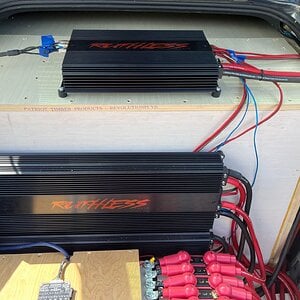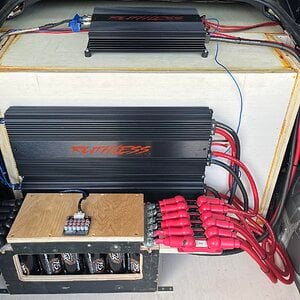Thank you! Most of that made sense to me, but what I'm just not getting is if I set my gain with the eq flat and turn the gain up until i reach my desired voltage, wouldn't then tweaking the eq and turning the bands up cause me to clip? I'm not saying I don't trust your answer, I'm just trying to understand

also when you say tweak, how much do you consider tweaking.... for example tweaking it from 0db flat to to +3db... or tweaking it from 0db flat to say +10db?
I get your questions.. I do. Someone else can probably explain the technical side of it a bit better -- But the EQ itself is just enhancing the levels across the band from 40hz to 20,000Hz -- You bump those "levels".. but it's not the same as turning the gain knob. So no, you won't be clipping .
And, to the BEST of MY understanding -- Setting it with the EQ flat essentially is keeping you from doing so. Why? Because it's giving you ROOM to play with the eq up or down. That's why "flat" or right in the middle is the way to go. You go down on some settings in the EQ, and up on some.. you know? So it sort of balances out. I promise you won't be clipping with a flat EQ setting gains, then tweaking the EQ by ear with real music.
Personally.. My amps have plenty of power -- And this is the way I do it to be as "Sure" as I can without an O-scope or DD-1 to ensure I'm not clipping (inaudibly) -- I set the voltages.. let's say the Calculator tells me to set X speaker to 34volts (random number) -- Well I'll dial the gain up to 34volts with the DMM,.. THEN, I'll back it down half a volt to 1 volt. (That's just me) -- but that gives me ample room that I'm not pushing the speakers at their "edge" essentially.. dam.n close (as say 0.5v isn't going to make a real audible difference) -- but it gives that little headroom.
Further,.. Gains, as you know, don't go to max.. they shouldn't anyway. IE: Say you have 4V pre-outs,.. Well.. even if your amp does 70x4 -- But your 4 speakers are 80watts RMS -- Well,.. as you turn that Gain dial you aren't going to get close to 100% on the dial even when you are getting to "max" voltage and RMS wattage for the channel.
Example -- I use a PPI 900.5 (5 channel amp) -- Which at 5 channels and 4 ohms.. is rated at 70w RMS x 4 and 270w RMS x 1. I run all 4 of my mids/tweets at 70watts RMS (but back them off by 0.5v ish) -- And My gains are at 45-50% on the amp. SO many people think the gain knobs are literal volume controls and if you need to use ALL of the rated power you are going to need to turn to max.. but it's just not the way it works.
For the Sub (which the sub is rated at 300w RMS) -- The amp will push 270w RMS x1 (Rated) -- And that gain at the FULL 270watts (I didn't back the sub down at all) -- is at 55-60%. You'll see this when you are setting your gains.. Now you may end up at 70% or 25-30% on your gains.. it's just increasing that 4v pre-out (or whatever your pre-outs are).. at 12-14.4v typically to your calculated voltage which will equate to the needed Watts RMS. (Peak is of no consequence.)
This is part of the reason people argue and debate about using 0dB test tones.. -5dB test tones and so on.. due to clipping potential (how clean the signal is.. and it gets much more complicated).
but you really don't need to overthink this (Hypocritical coming from me) -- but I researched the He.ll out of this.. And I promise,.. Setting your EQ flat.. and just as I said in previous posts will net you SAFE results.
You have to work with what you have -- Most of us don't have O-scopes or DD-1's.. So we have to work with calculations and Multi-meters.. which will get you pretty darn close.. Some people don't even use a meter, they turn it up till they AUDIBLY hear clipping then back it down a touch and that's that. But if you've ever watched an O-scope.. there is clipping you have a really hard time audibly hearing.. so this method , imho, (of turning gains till Clip/distortion is audible, then back down a tad..) is one I wouldn't personally use.
Others will chime in here.. But I literally JUST did mine with this method, and everything turned out beautiful!
Setting your gains is the FUN part of the install //content.invisioncic.com/y282845/emoticons/wink.gif.608e3ea05f1a9f98611af0861652f8fb.gif


